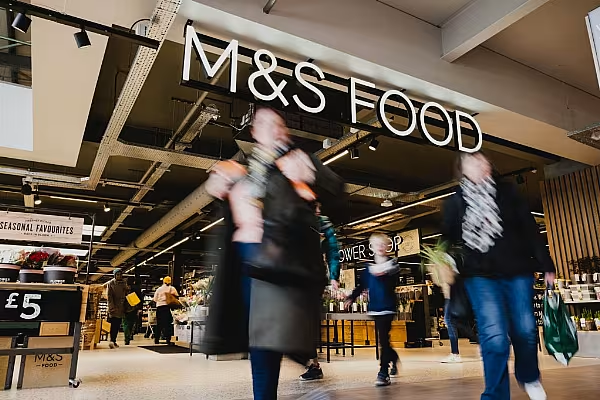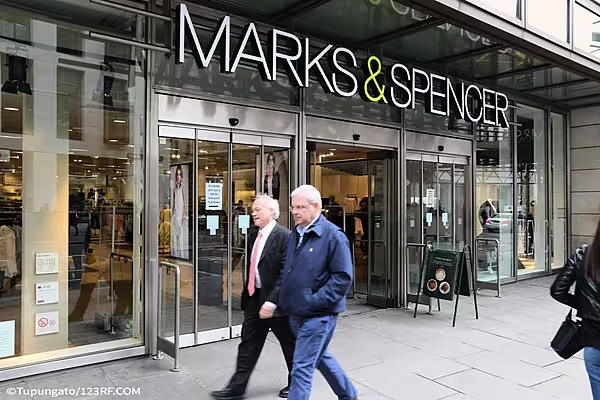British retailer Marks & Spencer reported a 17.2% increase in profit, to £407.8 million (€489.5 million), in the first half of its financial year, driven by market share gains.
Sales in the food segment grew by 8.1% in this period, to approximately £4.2 billion (€5.04 billion), with LFL sales up by 7.5%. Clothing & Home saw sales growth of 4.7%, with LFL sales up by 5.3%.
Despite the positive results, Marks & Spencer CEO Stuart Machin insisted that there’s “more work to be done,” underlining positive dissatisfaction for future growth.
‘The easy thing to do today would be to simply say that these are good results, but that wouldn’t be the right thing to do,’ Machin wrote in a LinkedIn post.
‘In the spirit of being positively dissatisfied, we still have so much more to do over this year and beyond. Despite our strong trading momentum, there is still so much opportunity for future growth – and this energises us!’
ESM takes a look at how analysts viewed the company’s first-half performance.
Shore Capital
Summing up the company’s performance, Shore Capital wrote in a note, ‘Marks & Spencer is probably in its best condition approaching a key Christmas trading period than it has been for many years, reflected in a further smashing of both our and consensus forecasts in H1 FY25.
‘Such an ongoing performance can feed rating expansion, which means the M&S share price may just have some way to run yet. The profit doors have been blown off again.’
Commenting on the Clothing & Home segment, the firm stated, ‘Perhaps the most pleasing, certainly the more difficult, self-improvement at M&S has been that in the Clothing & Home (C&H) markets when compared to Food.
‘The sales progression and market share gains (consecutively for 4Y now) have been a central manifestation of the improvement in the perception of the M&S brand by shoppers, which is now quite a self-perpetuating energy that, if nurtured, can support ongoing growth for some time, in our view.’
For the Food segment, Shore Capital added, ‘The very strong and sustained performance of the Food operations has been a little short of extraordinary, to our minds; driving strong growth on strong growth on strong growth.’
It added that progress in the Food division was driven by ‘improvements to its assortment, better laid out stores (converted and new), higher operating standards, especially around availability, and so more shoppers, especially trolley shoppers over those purely of a basket variety.’
Third Bridge
According to Third Bridge, M&S is ‘regaining British customers’ trust in clothing by focusing on value-for-money and sustainability. They’ve improved at quickly reacting to fashion trends, thanks to a clearer understanding of their customers and faster lead times that allow for testing and quick restocking of popular items.’
Third Bridge added, ‘Home presents a huge opportunity in the UK, with few competitors offering affordable, well-designed furniture. Our experts believe Home, like Food, can attract customers who haven’t considered M&S Clothing in a while.
‘One of M&S’s biggest advantages in the Clothing & Home segment is its strong store portfolio in prime locations, combined with its popular Food offerings, which help attract steady foot traffic.’
The investment firm added that, going forward, M&S should ‘adopt a more selective marketplace strategy, focusing on curated offerings that add clear value, rather than on boarding brands indiscriminately.
‘It needs to have a strong rationale for its marketplace approach, asking which third-party brands truly align with its goals.
‘There are also opportunities for M&S to expand into branded sports footwear, outdoor wear, and beauty products, filling product gaps and strengthening its appeal,’ it noted.
AJ Bell
‘When the clothing business was badly out of fashion, it was food which really sustained Marks & Spencer, and it’s this part of the business which is behind today’s better-than-expected profit,’ AJ Bell analyst Russ Mould wrote in a note.
‘The clothing business also delivered a robust performance and, all in all, that added up to a very decent showing from the retailer. It offered further evidence that a long-awaited turnaround for the business is gaining traction.
‘The company certainly sounded in a confident mood about building on the progress it has made and taking share from its rivals. A strategy of introducing lower price lines in food has been a success and, in clothing, the company now appears to be better attuned to the appetites of shoppers.
‘While initiatives like shuttering underperforming stores, opening more food outlets and making improvements to its technology and infrastructure are not rocket science, they have undoubtedly delivered for the business.
‘Marks & Spencer does sound a cautious tone on the impact of the Budget, which will inevitably lead to some cost inflation. The company’s financial position continues to improve, with a modest reduction in net debt.’













